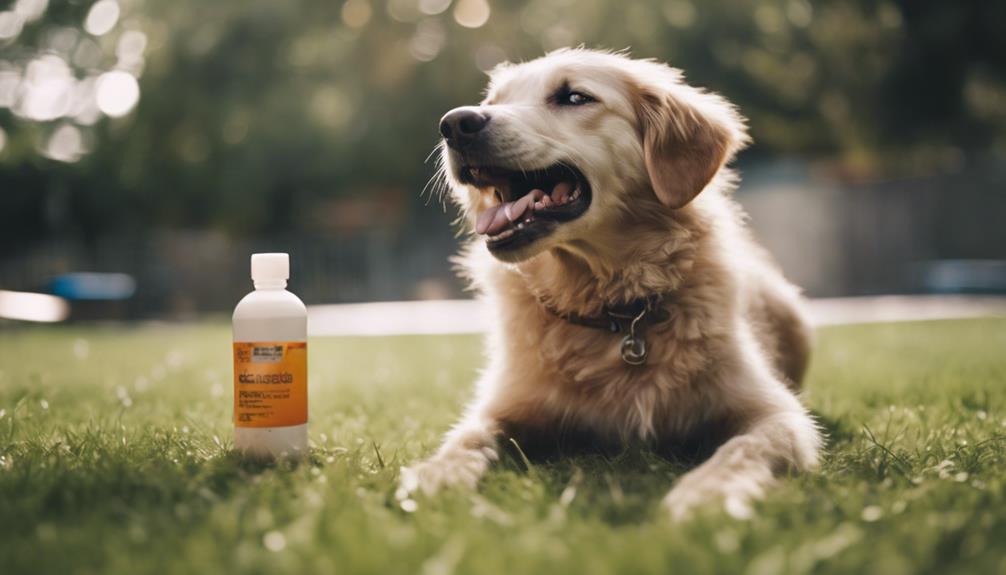Mange, a skin condition in dogs caused by specific mites, requires careful attention to symptoms and treatment for effective management. Recognizing the signs of sarcoptic and demodectic mange is paramount, as each type necessitates a distinct approach.
While sarcoptic mange demands swift veterinary intervention and specialized medications, demodectic mange requires a tailored treatment plan under professional guidance.
However, the discussion does not end here; understanding the importance of preventive measures and the role of regular veterinary check-ups in combating mange is equally crucial.
Key Takeaways
- Sarcoptic and demodectic mange in dogs have distinct causes, symptoms, and treatments.
- Sarcoptic mange is contagious and requires isoxazoline medications for effective treatment.
- Demodectic mange is not contagious but needs vet diagnosis and medication, especially in severe cases.
- Prevention involves regular vet check-ups, isoxazoline medications, and maintaining good hygiene practices.
Types of Mites Causing Mange
The development of mange in dogs can be attributed to two primary types of mites: sarcoptic mites, responsible for causing scabies, and demodectic mites, which are naturally occurring and non-contagious.
Sarcoptic mites, also known as scabies mites, are highly contagious and are typically transmitted through direct contact with infected animals or contaminated bedding. On the other hand, demodectic mites are commonly found in the hair follicles and oil glands of dogs and are usually passed from mother to pup during the early stages of life.
Understanding the distinction between these two types of mites is crucial for proper diagnosis and effective treatment of mange in dogs.
Symptoms and Treatment of Sarcoptic Mange
Upon encountering sarcoptic mange in dogs, recognizing the distinct symptoms and promptly initiating the appropriate treatment is paramount in mitigating the spread and severity of this highly contagious condition. Sarcoptic mites cause intense itching, especially around the ears, elbows, belly, and legs. If left untreated, sarcoptic mange can lead to serious skin problems.
Diagnosis by a veterinarian is crucial for accurate identification, with treatment typically involving isoxazoline medications to effectively eliminate the mites. It is essential to isolate infected dogs, thoroughly clean their environment, and follow vet instructions to prevent re-infection.
Early detection and treatment play a vital role in managing sarcoptic mange and preventing its transmission to other pets and humans.
Symptoms and Treatment of Demodectic Mange

What are the distinguishing symptoms and recommended treatment for Demodectic Mange in dogs?
Demodectic Mange, caused by Demodex canis mites, presents with specific symptoms and requires appropriate treatment. Here are key points to consider:
- Symptoms: Hair loss, oily skin, itchiness, and skin discoloration.
- Common in puppies, older dogs, or those with weakened immune systems.
- Potential for bacterial infections in generalized cases.
- Treatment involves a vet's diagnosis and may include isoxazoline medications and additional prescriptions.
Importance of Vet Diagnosis
Underlining the significance of early identification and precise treatment, veterinary diagnosis plays a pivotal role in effectively managing and combating mange in dogs.
A veterinarian's expertise is crucial in accurately identifying the type of mange present in a dog, whether it be sarcoptic or demodectic, as treatment approaches differ. Through thorough examination and potentially skin scrapings or biopsies, a vet can confirm the diagnosis and recommend the most appropriate course of action.
In cases of sarcoptic mange, prompt diagnosis is imperative due to its highly contagious nature, while demodectic mange may require a more tailored treatment plan based on the dog's age, health status, and extent of the infestation. Seeking professional veterinary guidance ensures the best possible outcome for the affected dog.
Prevention With Isoxazoline Medications

Early intervention with isoxazoline medications is instrumental in preventing and managing mange in dogs effectively. These medications can be a crucial part of your pet's healthcare routine to ensure they stay healthy and free from mites.
To effectively prevent mange with isoxazoline medications, consider the following:
- Administer the medication as prescribed by your veterinarian.
- Ensure all pets in the household are treated to prevent cross-infection.
- Follow up with regular applications as recommended by the vet.
- Combine medication use with good hygiene practices to minimize the risk of re-infestation.
Role of Regular Vet Check-ups
Regular veterinary check-ups are essential for dogs to maintain their overall health and well-being. These check-ups enable timely detection and prevention of mange and other potential health issues. Veterinarians conduct thorough physical examinations during these visits to check for signs of mange, like hair loss, itching, and skin abnormalities. Early detection is crucial for successful treatment and preventing the condition from worsening. Vets may recommend preventative measures, such as regular parasite control and skin screenings, to lower the risk of mange infestations. By being proactive with regular vet check-ups, dog owners can help protect their pets against mange and other health concerns, ensuring a happier and healthier life for their canine companions.
Preventing Sarcoptic Mange Transmission

Maintaining a vigilant approach to preventing the transmission of sarcoptic mange in dogs is paramount, especially considering its highly contagious nature and potential risks to both pets and humans.
- Isolate infected dogs to prevent spread.
- Thoroughly clean and disinfect items they have come into contact with.
- Avoid allowing infected dogs on furniture or in common areas.
- Follow vet instructions diligently to minimize the risk of re-infection.
Essential Hygiene Practices
Practicing stringent hygiene measures is imperative in preventing and managing mange in dogs effectively. Regularly bathing dogs with a gentle, medicated shampoo can help alleviate symptoms and remove mites from the skin.
It is crucial to thoroughly clean and disinfect the dog's living environment, including bedding, toys, and common areas, to prevent re-infestation. Washing all items in hot water and vacuuming carpets and furniture can help eliminate mites and their eggs.
Additionally, practicing good hygiene habits for all pets in the household can reduce the risk of cross-contamination. By maintaining a clean and hygienic environment, pet owners can significantly decrease the likelihood of mange infestations and promote the overall well-being of their dogs.
Conclusion
In conclusion, recognizing the symptoms of sarcoptic and demodectic mange in dogs is crucial for timely treatment. Veterinary diagnosis and tailored treatment plans are essential in managing these conditions effectively.
Preventive measures, such as regular check-ups, proper hygiene, and avoiding sources of infection, play a vital role in preventing the spread of mange.
Utilizing isoxazoline medications under veterinary supervision can help eradicate sarcoptic mites and maintain the health of dogs.




